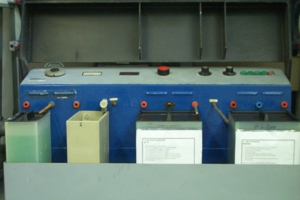Electro-Plating
Electroplating and external electroless plating

Electroplating and external electroless plating
Electroplating and external electroless plating offer a practical tool to prepare functioal coatings on a multitude of materials (metallic and nonmetallic). Galvanic metal deposition takes place in an electrochemical cell with an external DC power supply attached to two electrodes. The material which is to be coated is connected as a cathode (-) and the anode (+) is a rod of the metal to be deposited. Both electrodes are immersed in an aqueous solution of the metal salt which is to be deposited. Chemical reactions take place at the electrodes: Reduction (gain of electrons) of metal cations on the cathode resulting in the formation of a coating and oxidation (loss of electrons) of anions at the anode. Oxidation of the anode can also take place. The coating which develops on the cathode should be electrically conducting for the process to go on without electrode passivation.
For electrically non-conducting plastics and ceramics, adsorption of catalytic metal seeds (e.g Pd) is necessary to generate an excess of electrons allowing the reduction of the metal cations in the electrolyte and resulting in coating of the cathode. This electroless plating is a chemical reduction process which depends upon the catalytic reduction process of metal cations in an aqueous solution containing a chemical reducing agent without the use of electrical energy. The process takes place at a much slower rate than the galvanic and leads eventually to the formation of a “first layer” of the metal (usually Cu or Ni). This “first metal layer” renders plastic or ceramic objects electrically conductive facilitating the deposition of a further galvanic functional coating. Appropriate surface pre-treatment sequence and accurate process control are essential in order to obtain coatings with good adhesion and excellent performance.
The electroplating and electroless process offer distinct advantages
when plating irregularly shaped objects, recesses and internal surfaces.
A variety of different functional coating systems can be deposited (plated)
for corrosion protection, wear resistance, and other applications. Typical
functional coatings are Cu, Ni, Ag, Cr and Au. At our institute we are
primarily involved in the development of adherent metallization on electrically
insulating materials as well as high performance plastics and ceramics.
